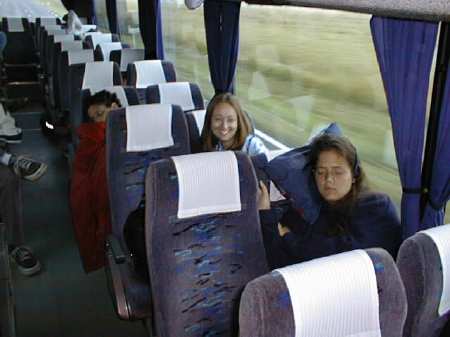
West Virginia University in Vendée, France

It is no small irony that today's visit to the European Park of the Image at the Futuroscope is among the most difficult of our outings to document in pictures. The fascination with images in this land we now call France goes back to the ancient cave paintings found in several sites around the country. Other high points of this trajectory are the stained glass windows of the Gothic cathedral and the Impressionist paintings of Manet, Monet, Cézanne, Van Gogh, and friends. The "modern" era of image production goes back to the early 1800's when Frenchmen Joseph Niepce and then Louis Daguerre perfected the processes and machines that made photography a new form of art and communication. By the end of the last century ( December 25 1896) the legendary Lumière brothers, chemists from Lyon, opened the doors of a Parisian café to a small public who witnessed the projection of the world's first "moving pictures". What the French call "the Seventh Art" was born. The Futuroscope, near Poitiers, is in essence a gigantic celebration of this seventh art, and the exhibits here offer an overwhelming array of projection -- three dimensions, 360 degrees, screens three floors high, superhigh resolution, digital, interactive, and on and on.... A dream realized in the 1980's by stateseman René Momory, the Futuroscope has also evolved to become one of the great educational and research facilities of the world. Much of the enormously important French Ministry of Education (it does work corresponding to all the small boards of education, boards of regents, etc. in the States) is now housed on these grounds. The research facilities here do a full 8% of the scientific experimentation and development carried out in France. It is thus greatly humbled that I present the few modest pictures below.
Poitiers is a three-hour drive from Les Sables, so we are up early to catch the Vendée-Mobile which leaves this morning at 6:00 am. Since school is now out in France and since the Futuroscope is one of Europe's leading attractions (some 3 million visitors a year), we have several guests from host families with us today. Below, heads of our WVU-Vendéens and guests have sunk below the seats as they catch up on the sleep they've lost either during our excursions or during the grueling exams the mark the end of the French school year. Here only Betsy Goosman has a perky smile. She has recovered well from the bug that bit her earlier this week.

One in the park, we divide into small groups and we're off. Below, one of the groups poses before one of the many impressive projection halls in the park. The "Crêtaux" in this picture are relatives of Dr. V. Lastinger. From left to right: Sylvain Crêtaux, Alexander Lastinger, Jennifer Campbell, Betsy Goosman, Hélène Crêtaux, Antoine Crêtaux (Jennifer's host "father"), and Mona Iskander.
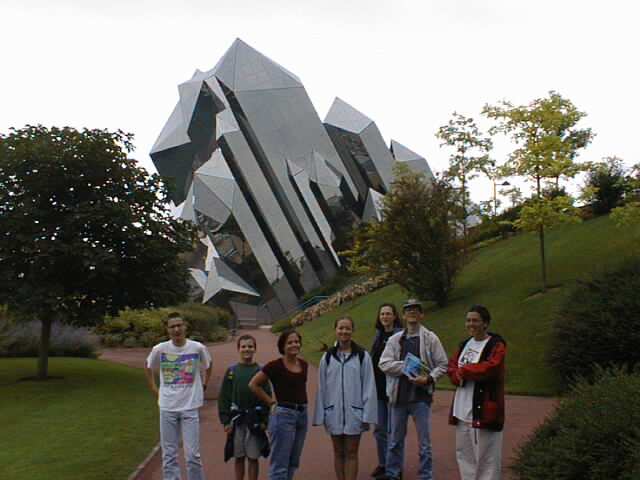
Below is a projection room with a 360 degree documentary on the recent European
championship of three-hull sailing vessels. The sea is literally everwhere you look!
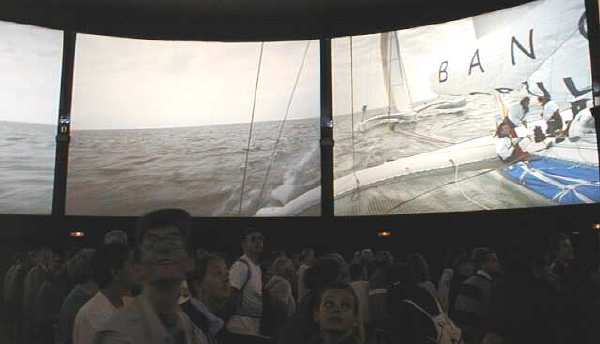
One view which is not a procection is that from the spinning tower that rises above the park. Below, Megan Sadler, Betsy Goosman and Mona Iskander enjoy the view over the park and over the plains where in the 732 Charles Martel stopped the advance of the Sarrasin armies that threatened to overtake all of Europe. Martel's grandson, Charlemagne would push the Islamic forces back beyond the Pyrenees and become emperor of a vast united Christian Empire.
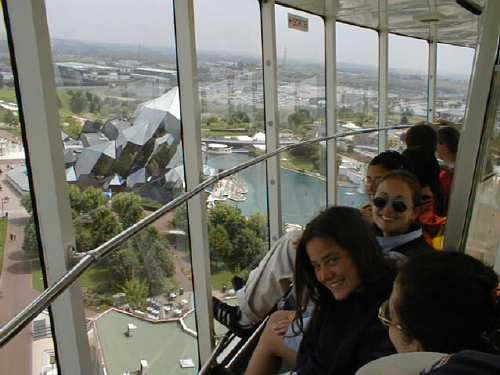
Below, the projection sphere atop one of the projection rooms is not really a soccer ball, but it reminds some of the critical game between France and Italy that will take late this afternoon as we take the road back to Les Sables.
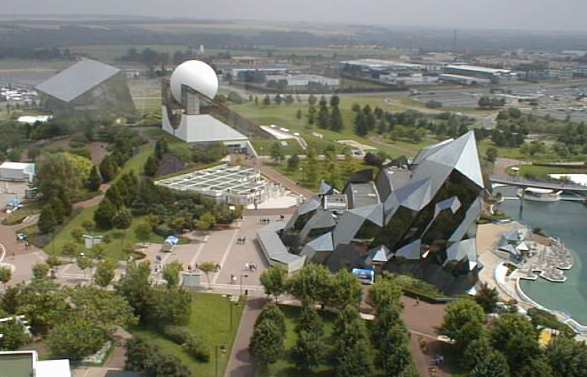
That game starts in fact at 4:30 pm today. The Vendée-Mobile leaves the
Futuroscope a little past 5:00 so we expect to pass some of the ride in the grips of
a 90-minute game that pits France against it trans-Alpine neighbor. As it turns out
the game goes on and on. France dominates play, but is unable to score. On and
on we go on the edge of our seats. Radio stations fade in and out. Regulation
time ends. No score. Two sudden death prolongations end. No score.
Now the flip-of-coin "kick off". Each team chooses its five best
kickers. They alternate in close kicks against the other team's lone goalie.
Eight kicks and each team stands with three goals entered, one each missed. France
enters its fifth kick. Now the last Italian stands forward. . . . These free
kicks are seldom missed. It looks another series will be necessary. The
tension is indescribable. The radio broadcast flickers as the Vendée-Mobile drives
by the menhirs of prehistory that dot the surrounding pastures. Did we hear
right? We look around at each other. Yes? No? Right, the last
Italian kicker has missed. "Les Bleus" will go on to the
semi-finals. Jubilation. Before we know it we're back in Les Sables. The
honk of horns and fans waving the three colors of the Republic pass by as we get off the
bus and head toward our homes by the sea.
Stay tuned to WVU-V!
Go on to July 4, 1998.